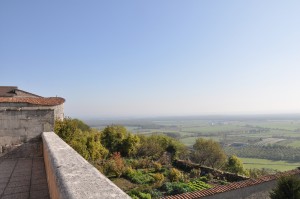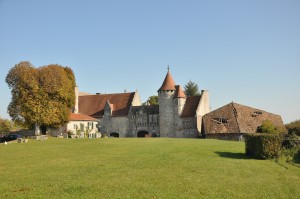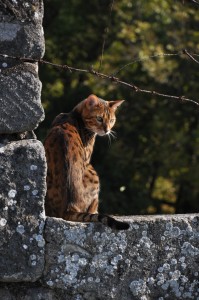The visitor’s guide to Hattonchâtel opens with a discussion of geology established 150 million years ago as rivers cut down through soft strata leaving limestone bluffs to tower over the plain, a perfect natural fortification and a position that provides gorgeous views to each of the compass points. Its “modern” history dates to the ninth century when Lothaire II, son of King Louis the Pious, presented the land to Hatton, the 29th archbishop of Verdun in thanks for permission to divorce his first wife. For the next seven centuries, the castle Hatton built remained a happy retreat for his successor bishops. In the 16th century, Hattonchâtel passed into the hands of the Dukes of Lorraine. In the 17th century, following the harrowing Thirty Year’s War, Cardinal Richelieu ordered the razing of the ramparts and shortly thereafter permitted the Swedes, allies of the French, to sack the city. The next three hundred years or so seem to have encountered little change. The castle and church at the summit looked then and now out over the small towns and fertile fields below, watching life unfold in its comparative orderliness and absolute inevitability.
In September 1914, Hattonchâtel was overrun over by German troops. The bulge of the St. Mihiel Salient, like some monstrous amoeba, absorbed the town like the others of the Meuse valley as they moved to capture Verdun, making of the Front a giant pincer. They stayed in residence until September 1918 when 150,000 American troops and their fearsome armaments joined with French troops to retake the Salient and begin the final push to the east and victory. It was, in fact, the 26th, the “Yankee Division” in which Grandfather David was a lieutenant in the 103rd and 101st Infantry Regiments that liberated this particular town.
Enter Ruth Isobel Skinner.
Belle, a textile heiress from Skinnerville, a town near Holyoke, Massachusetts, discovered the ruins of Hattonchâtel in late 1918 during a tour of the “Red Zone,” the area in the Salient where more than 80 percent of the buildings had been reduced to rubble. She, in the way of 19th-century wealthy American spinsters (she was born in 1866 and educated at Vassar College), simply moved in and took over. She built a home—now a very upscale gîte—and financed the reconstruction of the castle, the Mairie, and the cemetery, all with such modern conveniences as running water and central heating where relevant. Her purse was open to villagers rebuilding their homes, too, and the final tally is estimated at one million dollars, about twelve million of today’s euros, according to the guidebook, or about sixteen million dollars. The architects she called on were, to my surprise at any rate, modernists associated with Frank Lloyd Wright (or Franck Wright Lloyd as the book says).
Inspired by the work of Louis Ernest Nivet (1971-1948) she commissioned from him a monument to the village dead. Nivet had worked in the atelier the famed sculptor Auguste Rodin although his approach was certainly more conservative, academic and Romantic.
She hired the American architect John D. Sanford (I wonder if he is some remote relative?) to reconstruct the Mairie. Inspired by Romanesque ecclesiastical structures, he designed a pair of wings joined by a round arch supported by columns. The arch leads to a sort of atrium, more a patio really, that offers a panorama, east to south, of the plain below. I wish I had known what I was looking at: apparently on can make out the American monument on the butte de Montsec, some 11 kilometers distant.
Belle, her work, and Hattonchâtel were celebrated in a lengthy poem penned by musicologist Charles Louis Seeger, Jr. (1886-1979), brother of poet Alan Seeger (1888-1916), author of I Have a Rendez-Vous with Death, an American who joined the French Foreign Legion and died in battle a full year before the United States entered the war. (And, of course, C.L.S. was the father of folk-music icon Pete Seeger, b. 1919).
It was a quiet Monday. The streets were empty and the historic sites were locked up tight. A lovely woman, however, ran out with a key to the Collegium, one of those religious communities associated with a church that cannot claim the status of cathedral. It is a lovely old building with beautiful stained glass from ancient to modern times and a remarkable retable that may or may not—depending on the scholar you read—be the work of Ligier Richier. Richier, born around 1500, was Lorraine’s foremost sculptor. While he never traveled to Italy, he is the foremost exponent of the early Renaissance in France.
We met, as well, a regal presence in that place. Near the castle, we encountered a remarkable feline, a lady of gold and red with topaz eyes and the markings of an ocelot. A bewhiskered dachshund charged, yapping ferociously and this divine creature retreated prudently but calmly into a thicket of grasses. With the doggie gone and peace restored, our princess chatte, for surely she must be of royal blood, permitted photographs and brief caresses. Such silken fur! Such luxurious color! We encountered Her Highness later after completing a circuit of the town. She graciously permitted a last embrace and then left to accept the worship of another pair of tourists.






